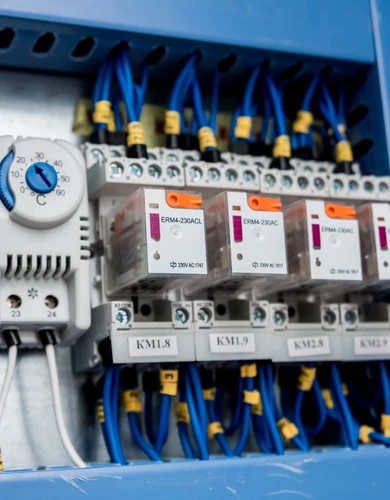The role of Liquified Natural Gas (LNG) in the UK
Liquefied Natural Gas (LNG) plays a critical role in the UK’s energy landscape, supplementing declining domestic gas production and addressing supply shocks caused by global events.
As the UK transitions to low-carbon energy sources, LNG remains vital for maintaining energy security despite its higher costs and environmental impact.
This article examines LNG’s production, distribution, and future in the UK, along with its implications for energy security, pricing, and the country’s commitment to achieving net zero by 2050.
Contents
- What is Liquefied Natural Gas (LNG)?
- LNG infrastructure in the UK
- The role of LNG in the UK
- The future of LNG in the UK
What is Liquefied Natural Gas (LNG)?
Liquefied Natural Gas (LNG) is natural gas converted into a liquid state by cooling it to -162°C (-260°F).
In this liquefied form, LNG takes up 600 times less volume than regular natural gas, making it significantly more efficient to transport by sea, road, or rail and long-term storage in specialised cryogenic tanks.
These properties make LNG ideal for supplying natural gas to remote or hard-to-reach areas lacking sufficient pipeline infrastructure, or to deliver gas when pipeline gas becomes insufficient (as is the case in the UK).
What are the pros and cons of LNG?
The rival to LNG is pipeline natural gas, which is delivered directly from refineries via an extensive gas pipeline distribution network called the National Transmission System which is connected to the European continent via three undersea interconnectors.
The table below outlines the pros and cons of each, helping to clarify their respective role in the UK energy market.
| LNG | Pipeline Natural Gas | |
|---|---|---|
| Transportability | Can be shipped globally, over long distances. | Limited to regions connected by pipelines. |
| Infrastructure | Requires complex liquefaction, storage, and shipping. | Requires extensive pipeline networks. |
| Cost | Higher cost due to liquefaction and transportation. | High capital cost, but lower cost in the long-term due to continuous use of infrastructure. |
| Access | Can be accessed anywhere within sea, rail, and road networks equipped with regasification plants. | Restricted to areas with pipeline networks. |
| Environmental Impact | Unavoidable methane leakage risk, energy-intensive processes. | Less energy-intensive, less methane leakage but still emits CO₂. |
| Supply Security | Can diversify supply by importing from various regions. Immediate supply at the right price. | Vulnerable to political and supply disruptions in pipeline routes. |
How is Liquefied Natural Gas (LNG) produced and distributed?
LNG production and distribution typically goes as follows:
- Production: Liquefied Natural Gas (LNG) is produced in a liquefaction plant after natural gas is extracted from deep underground reservoirs and purified into a product containing 85-95% methane.
- Transportation: Once liquefied, LNG is transported in cryogenic tanks via specialised vessels, trucks, or trains, depending on the destination’s accessibility. In the UK, LNG is imported by sea in vessels and distributed by pipelines.
- Regasification and distribution: Before LNG can be used for industry, heating, or electricity generation, it must be converted back into its gaseous form. Regasification occurs at the receiving terminal in a specialised plant, where the LNG is reheated to ambient temperature and turned back into gas for distribution through pipelines.
- Purchases: Natural gas is purchased by domestic and business gas suppliers who distribute it to individual customers.
💡 There is no domestic LNG production in the UK. 100% of its North Sea and East Irish Sea gas is distributed via pipelines for domestic use or exported via interconnectors into Europe. All LNG in the UK is imported from abroad via sea.
LNG infrastructure in the UK
The UK’s LNG infrastructure is concentrated in its three import terminals because distribution within the country can be done through its existing pipeline network.
We first explain the role of LNG terminals for imports and storage and then delve into how this gas is distributed to consumers nationally.
LNG import terminals
The UK has three main LNG terminals that handle the import, storage, regasification of LNG and its injection into the UK’s national gas transmission system:
| LNG Terminal | Import Capacity (Billion Cubic Meters per year) | Storage Capacity | Description |
|---|---|---|---|
| Grain LNG Terminal (Isle of Grain, Kent) | 20 BCM | Over 1 million cubic meters | The largest LNG terminal in the UK and one of the largest in Europe. It handles significant imports, storage, and regasification for the National Transmission System (NTS). |
| South Hook LNG Terminal (Milford Haven, Wales) | 21 BCM | 775,000 cubic meters | A major terminal in Europe, jointly owned by Qatar Petroleum, ExxonMobil, and Total, primarily handling LNG from Qatar. |
| Dragon LNG Terminal (Milford Haven, Wales) | 8 BCM | 320,000 cubic meters | A smaller terminal but crucial for receiving and regasifying LNG for the UK market. |
National Transmission System (NTS)
Thanks to its gas reservoirs in the North Sea and East Irish Sea, the UK ranks as the world’s 21st-largest natural gas producer.
The majority of this domestic gas production is used for heating, industry, and power generation, supported by a vast network of over 8,000 kilometres of pipelines known as the National Transmission System (NTS) and its private equivalent, Independent Gas Transporters.
Nearly all imported LNG is distributed efficiently through this network, reducing the need for LNG transportation by rail and minimising road transport for areas not fully served by the NTS.
The role of LNG in the UK
The UK’s LNG imports play a key role in the UK energy market, namely by:
LNG imports to meet natural gas demand
LNG imports have become necessary to meet the UK’s domestic demand for natural gas. Here’s why:
Steady decline in domestic gas production
This stems from the steady decline in gas production from the UK’s North Sea fields. Currently, domestic production meets only around 54% of the UK’s natural gas demand, leaving a significant shortfall that imports must cover via pipeline connections from mainland Europe and Norway, or through LNG shipments.
The following graph shows these shifts in demand, production and imports over the last three decades:
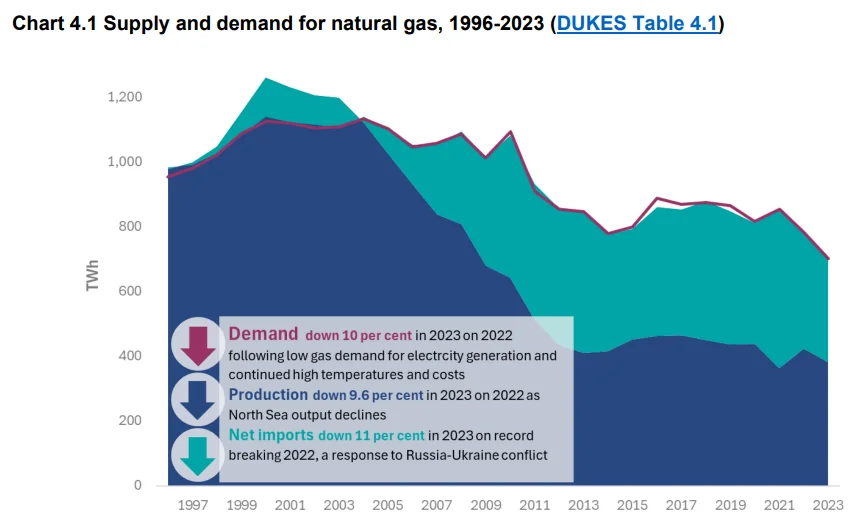
LNG imports
Initially, natural gas imports via pipeline interconnectors with mainland Europe and Norway were sufficient to cover the shortfall from declining UK gas fields.
However, as domestic production continued to decrease, these pipeline imports had to be supplemented by LNG shipments.
This began in 2005 and grew significantly after 2010. Since then, LNG imports have fluctuated between 20% and 40% of the total gas imports, depending on market conditions, production, and geopolitical events.
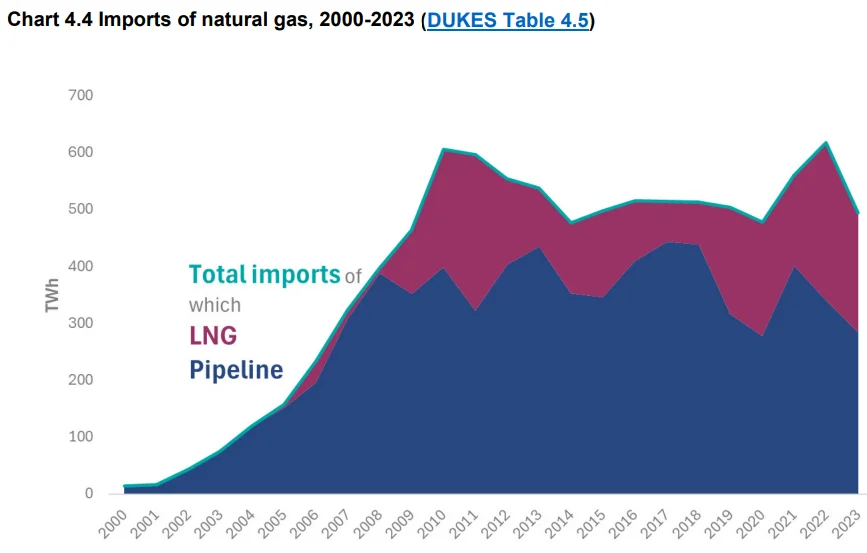
In 2023, 57% of the UK’s gas imports came from Norway via undersea gas pipelines, while the remainder was supplied through LNG shipments from various countries, primarily the United States (26%), Qatar (6%), and others from Africa and Latin America.
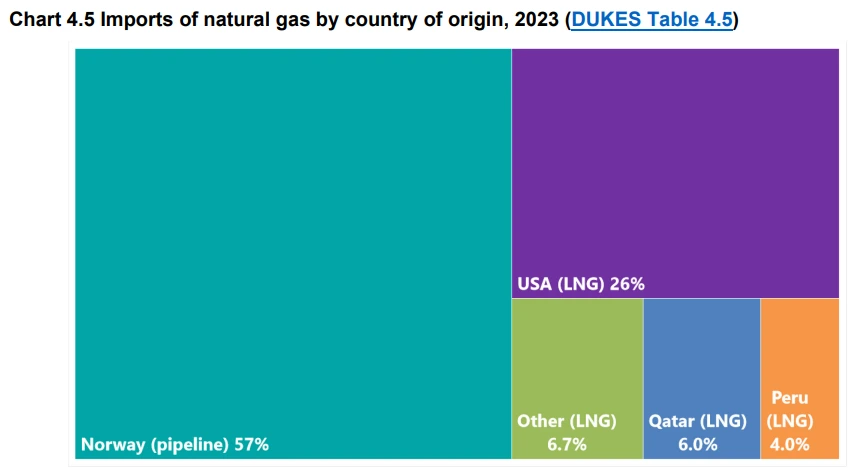
LNG for energy security
LNG imports have been crucial in ensuring the UK can meet its gas demand during supply shocks, such as the 2022 UK energy crisis. During this time, a combination of factors led to the need for increased LNG imports:
- A surge in natural gas demand post-COVID, as economies reopened and energy consumption rose.
- Disrupted gas supplies from Russia due to the conflict in Ukraine led to a significant reduction in gas flows to Europe.
- The closure of the Rough natural gas storage facility in 2017 had previously provided a strategic buffer for the UK during periods of high demand.
These LNG shipments were essential in helping to maintain supply and prevent an even sharper rise in prices. However, despite the influx of LNG, gas prices still soared to record levels due to global supply constraints and high demand.
The impacts of LNG imports
While LNG imports play a crucial role in the UK’s energy market, they come with significant economic and environmental consequences, including:
Increased costs of electricity and heating
LNG is inherently more expensive than pipeline gas due to the additional processing and energy required for liquefaction, transportation, and regasification.
As the proportion of LNG imports rises, it drives up overall natural gas prices, increasing domestic and business gas prices. This is especially impactful given the UK’s heavy reliance on natural gas.
In 2023, nearly 40% of the UK’s electricity was generated from gas power stations, so even small changes in natural gas prices impact domestic and business electricity prices.
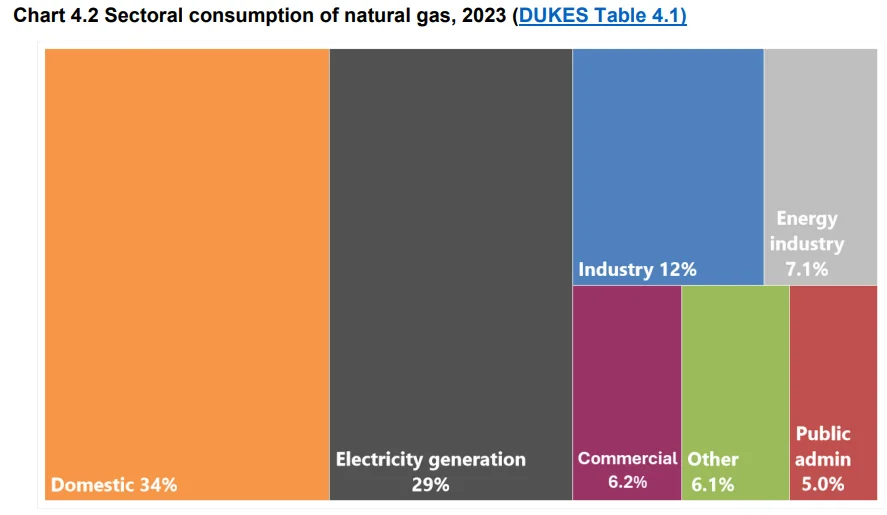
Increased carbon emissions
LNG production’s additional processing and transportation steps make it significantly more carbon-intensive than pipeline gas.
Substantial methane leakage occurs during liquefaction and regasification and emissions from its transportation by sea or land before being injected into the pipeline network for use.
Analyses show that the UK’s domestic gas production emits 21 kg CO₂ per barrel of oil equivalent (boe). In contrast, imported LNG emits nearly four times as much, at 79 kg CO₂ per boe by the time it reaches the UK for consumption.
While LNG imports are crucial for energy security, each time the UK relies on them to meet demand, it complicates the country’s legally binding commitment to achieve net zero by 2050, which requires the complete phase-out of unabated natural gas use.
The future of LNG in the UK
LNG imports will remain essential as long as the UK continues to rely heavily on natural gas for power generation, heating, and industry.
While the country is steadily decarbonising the energy grid and transitioning to renewable energy and heat pumps for heating, significant progress remains.
The government’s current plan for addressing this challenge is as follows:
The UK’s LNG plan
The UK government views LNG as a strategic temporary bridge fuel during the transition to low-carbon energy sources.
UK wind farms are already delivering significant amounts of electricity to the national grid, and nuclear power is experiencing a re-birth with Sizewell C deemed for completion over the next few years.
However, significant challenges remain. LNG will continue to play a crucial role in the short to medium term, particularly in maintaining energy security. The government is investing in LNG infrastructure and plans to use it for the coming decades. This includes:
- Continued LNG imports from strategic partners like the US, Qatar, and others.
- Ongoing investment in LNG terminals to maintain import capacity, ensuring flexibility in gas sourcing.
- Integrating carbon capture and storage (CCS) technology into LNG facilities to reduce emissions during the transition.
- Innovations aimed at reducing methane leakage and carbon emissions across the LNG supply chain.
The UK government is legally committed to phasing out unabated fossil fuels, including LNG, by 2050, giving time and flexibility to achieve this target.

